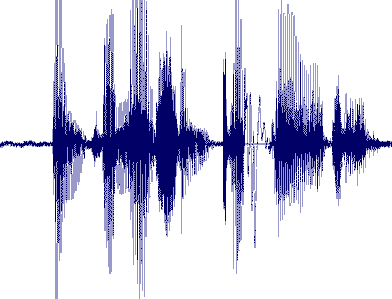

Information
that is easy to digitize:
Digitizing
Sound
Sounds can be recorded using a microphone, which converts the air vibrations of the sound into an electrical signal. This signal can then be quantified—but the digitization must include quantifying magnitude (loudness) and time.
One method of digitizing sound, the WAV (pronounced "wave") file, stores a digitized value for each point in time. This results in a large amount of data for recordings of moderate length. Other formats use clever tricks to compress the data. For example, if the recording contains a short section of silence, rather than storing a magnitude of 0 many times:
| 0 0 0 0 0 0 0 0 0 0 0 0 0 0 0 0 0 0 0 0 0 0 0 0 0 0 0 0 0 0 0 0 0 0 0 0 0 0 0 0 0 0 0 0 0 0 0 0 0 0 0 0 0 0 0 0 0 0 0 0 0 0 0 0 0 0 0 0 0 0 0 0 0 0 0 0 0 0 0 0 0 0 0 0 0 0 0 0 0 0 0 0 0 0 0 0 0 0 0 0 0 0 0 0 0 0 0 0 0 0 0 0 0 0 0 0 0 0 0 0 0 0 0 0 0 0 0 0 0 0 0 0 0 0 0 0 0 0 |
a compressed format would store the magnitude and the number of times it occurred:
| 0 (100 times) |
An example of a compressed format is the popular MP3 digital music standard. This format strips out parts of the audio signal which the human ear cannot easily hear. The resulting sound still sounds the same (or very nearly the same) as the original, but with a significantly fewer number of bits. That makes this format popular for use on the Internet, since many users want high-quality music but with relatively short download times.
Here is a sample WAV file: Information Technology Sound (your browser must have the appropriate sound plug-in to play this WAV file; otherwise try downloading it by right-clicking the link and then double-clicking the saved file). The image below shows the waveform that is encoded into the sound file. This shows how much your computer's speaker vibrates over time. You may even be able to pick out the syllables of the spoken phrase "Information Technology" in the waveform.

The WAV format does not use compression, so the size of the WAV file is rather large. Try listening to each of the sounds below. You'll hear that the first MP3 sounds almost identical to the WAV file, but with a much smaller file size. If even more compression is used, the file size decreases further, but the quality is degraded.
![]()
![]()
These pages were written by Steven H. VanderLeest and Jeffrey Nyhoff and
edited by Nancy Zylstra
©2005 Calvin University (formerly Calvin College), All Rights Reserved
If you encounter technical errors, contact computing@calvin.edu.